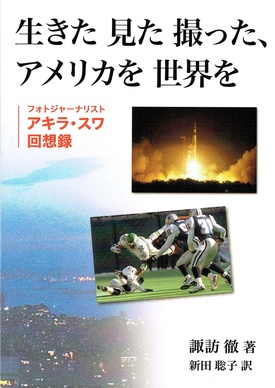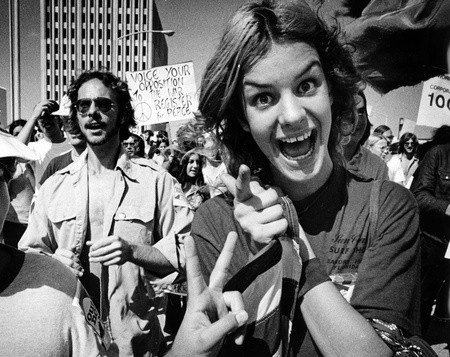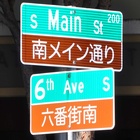Inspired by Kenichi Horie and Minoru Oda
Kenichi Horie (84), an ocean adventurer, was recently awarded the Blue Water Medal, the highest honor given by the Cruising Club of America (CCA), in recognition of his achievements in ocean adventure. Last year, Horie became the oldest person in the world to successfully cross the Pacific Ocean solo without stopping in a yacht, and has taken on many ocean adventures to date.
Horie attracted the world's attention when, in 1962, he achieved the feat of sailing solo from Nishinomiya Port in Hyogo Prefecture to San Francisco. His book about the voyage, Alone in the Pacific, became a hot topic and inspired the adventurous spirit of young people in Japan at the time. One of the many young people who did so was Akira Suwa, who later became a photojournalist in the United States.
Suwa, who lives in the United States, published Akira Suwa's memoirs last year, looking back on his life as a photojournalist. The book was written in English, but was translated into Japanese by his elementary school classmate, Satoko Nitta.
I learned about Suwa-san while I was putting together my book Yamato Colony: The Men Who Left Japan in Florida (Shunposha, 2015). It was Suwa-san who took the precious photographs of George Morikami, a central figure in this group of men and an immigrant from Japan, in the 1970s, and I used those photographs in my book. Morikami Sukeji came to own a large amount of land in one generation, and before his death he donated the land to the local area, which led to the creation of the Morikami Museum, which promotes Japanese culture in South Florida.
At the time he photographed Morikami, Suwa was a photographer for the Palm Beach Post in Florida, and it was surprising to me that a Japanese photographer was working for a newspaper in America, especially in Florida, at that time. Why was Suwa working as a photographer in Florida, where there are almost no Japanese people?
In 2012, I met Suwa in Philadelphia and learned the reasons for his decision and the story of his unique, challenging life.
"Memoirs" chronicles Suwa's journey as a photojournalist. The record of how a young man who went to America with dreams and aspirations got a job in a foreign country, succeeded in the world of photography, and established himself in America is an interesting account of how he learned about the dynamic world of photojournalism, and also as a success story set against the backdrop of American society and culture.
Below, following the Memoirs and with reference to the afterword by translator Nitta, I will trace the path that Suwa walked and the people and things he captured on camera.
First, I worked in gardening.
Suwa attended Osaka Municipal Taishibashi Elementary School and other high school education in Osaka, graduating from Tokyo University of Agriculture in 1966, but traveled to the United States twice during his time there. First, in 1962, he went to California for agricultural training, and two years later, he took a year off from university to work in the restaurant at the Japan Pavilion at the World's Fair in New York.
During this time, he saw Broadway shows, went to Beat jazz cafes, and traveled to New England and Mexico, which made him want to work in the U.S. after returning to Japan. Around the same time, he learned about the accomplishments of Kenichi Horie and read Makoto Oda's "Nandemo Mite Yaro," which sparked his desire to go on an adventure abroad.
Then, an American acquaintance of his father told him about a Japanese gardener wanted in Tampa, Florida, so Suwa immediately started working at a privately owned garden center in Tampa. However, after about a year, the garden center started to struggle, and Suwa had to quit his job.
Working at a newspaper
Then, luckily, he got his next job offer. Photography is his hobby, and after work he would take pictures of the scenery and neighbors in his neighborhood. One day, he met a person who ran a photo studio, and his skills were recognized, so he started working there. As he learned the job, the photos he took started to be published in newspapers, and he was then hired by the local newspaper, the Tampa Tribune.
Thus, Suwa, who started his career as a photojournalist at the age of 28, "worked twice as hard and twice as hard as the other staff members," learning from his colleagues and seniors, and furthering his career, he won a photo contest. Then, he was invited by the St. Petersburg Times, also on the Gulf Coast of Florida, to "come work for us."
In 1972, the paper was one of the few in the US that carried color photographs, and Suwa accepted the offer. By this time, Suwa had already married an American woman and had a daughter.
Professionally, he covered major news stories such as the opening ceremony of Disney World and the launch of Apollo 17. He also won the Newspaper Photography Excellence Award in a photo contest in 1973, sponsored by the University of Florida School of Journalism and Communications, which led to him being invited to work as the photo director of the Palm Beach Post on the Pacific coast, where he then moved.
Here, he created innovative pages by combining photographs to create stories. It was at this time that he learned of the existence of Morikami Sukeji, and spent about eight months photographing him.
In addition, he has interviewed many people in a wide range of fields, including golfers Jack Nicklaus and Laura Baugh, professional boxer Muhammad Ali, and Elvis Presley in his later years in show business.
Reporting around the world
In 1976, he was invited to work at the Philadelphia Inquirer, a traditional newspaper in eastern Pennsylvania, and left Florida for Philadelphia the following year. Since then, he has worked as a member of the photo department at the paper for 37 years.
In the book, he introduces some of the interviews he experienced during that time. In Japan, he interviewed people such as President Carter, Pope John Paul II, and author James Michener. Many of the other interviews were on international topics, and he was based in Philadelphia and traveled around the world, a job that was the standard for a photojournalist. However, it was sometimes dangerous and extremely stressful.
He has covered tough jobs such as Libya and Colonel Gaddafi (1986), the Gulf War in the Middle East (1991), the current situation in China (1995), and drugs in Colombia (2000), and in a more unusual turn of events, he has worked as an American journalist, covering a Japanese company that makes trolley cars and the Japanese people working there.
The book details the conditions in those countries (sites), the contents of the interviews, and the feelings he had at the time. Although he was sometimes scared, suffered, and shed tears, the theme that shows Suwa's deepest feelings is his interview (1988) with "Amerasians," children born to American soldiers stationed in Vietnam during the Vietnam War and local women.
Mr. Suwa himself has two daughters with an American woman, so he had strong feelings about children with mixed-race parents.
Suwa felt and reported on the plight of children born to Americans, especially blacks, in Vietnam. Since he was alone during the three-week interview, he wrote articles as well as taking photos. After that, Suwa heard news that the young Vietnamese he had interviewed had found a new place to live in America, and he felt the power of photojournalism, however small it may be.
After retiring from active duty, Suwa lives in his home in New Jersey. This 96-page book, which also includes photos taken by Suwa, was self-published with the intention of being read by his elementary school classmates. However, in the afterword, translator Nitta writes, "If by some chance this modest booklet catches the eye of a young person and, just as the writings of Kenichi Horie and Minoru Oda gave the author a push in his younger days, it would be a great joy for the author to go out into the wider world and find a meaningful job."
(Titles omitted)
*All photos were taken by Mr. Suwa.
© 2023 Ryusuke Kawai










